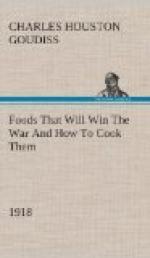America must fill the breach. Not only must we meet the present increased demand, but we must be prepared as the war advances to meet an even greater demand for this most necessary food. The way out of this serious situation is first to reduce meat consumption to the amount really needed and then to learn to use other foods that will supply the food element which is found in meat. This element is called protein, and we depend upon it to build and repair body tissues.
Although most persons believe that protein can only be obtained from meat, it is found in many other foods, such as milk, skim milk, cheese, cottage cheese, poultry, eggs, fish, dried peas, beans, cow peas, lentils and nuts. For instance, pound for pound, salmon, either fresh or canned, equals round steak in protein content; cream cheese contains one-quarter more protein and three times as much fat; peanuts (hulled) one-quarter more protein and three and a half times as much fat; beans (dried) a little more protein and one-fifth as much fat; eggs (one dozen) about the same in protein and one-half more fat. It is our manifest duty to learn how to make the best use of these foods in order to save beef, pork and mutton, to be shipped across the sea. This means that the housekeeper has before her the task of training the family palate to accept new food preparations. Training the family palate is not easy, because bodies that have grown accustomed to certain food combinations find it difficult to get along without them, and rebel at a change. If these habits of diet are suddenly disturbed we may upset digestion, as well as create a feeling of dissatisfaction which is equally harmful to physical well-being. The wise housekeeper will therefore make her changes gradually.
In reducing meat in the diet of a family that has been used to having meat twice a day, it will be well to start out with meat once a day and keep up this regime for a couple of weeks. Then drop meat for a whole day, supplying in its stead a meat substitute dish that will furnish the same nutriment. After a while you can use meat substitutes at least twice a week without disturbing the family’s mental or physical equilibrium. It would be well also to introduce dishes that extend the meat flavor, such as stews combined with dumplings, hominy, or rice; pot pies or short cakes with a dressing of meat and vegetables; meat loaf, souffle or croquettes in which meat is combined with bread crumbs, potato or rice.
Meat eating is largely a matter of flavor. If flavor is supplied, the reduction of meat in the diet can be made with little annoyance. Nutrition can always be supplied in the other dishes that accompany the meal, as a certain proportion of protein is found in almost every food product. The meat that we use to obtain flavor in sauces and gravies need not be large in quantity, nor expensive in cut. The poor or cheap cuts have generally more flavor than the expensive ones, the difference being entirely in texture and tenderness, freedom from gristle and inedible tissue. There are many cereals, such as rice, hominy, cornmeal, samp and many vegetable dishes, especially dried beans of all kinds, that are greatly improved by the addition of meat sauce and when prepared in this way may be served as the main dish of a meal.




